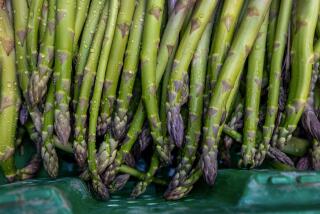Market Watch: Return of the Chandler strawberries
- Share via
“Oh, strawberries don’t taste as they used to,” wrote John Steinbeck in “East of Eden.” Never mind that the chapter was set a century ago; many foodies believe that industrial varieties and practices have degraded the flavor of modern strawberries. This spring we have an opportunity to test that hypothesis, as Harry’s Berries has resumed growing the Chandler variety, a longtime favorite at farmers markets for its tender, juicy flesh and classic strawberry flavor.
“It reminds me of what strawberries used to taste like when I was a kid,” says Kris Gean, 32, scion of the Harry’s Berries dynasty.
Chandler, bred by Victor Voth and Royce Bringhurst of the University of California, was introduced in 1983 and dominated production in Southern California in the late ‘80s and early ‘90s. Many of the varieties grown just before were cottony inside and tasteless, but Chandler had excellent internal color and flavor, and was ideal for processing.
Its most distinctive characteristic — its tender, juicy texture — was both its glory and its eventual commercial downfall. Most California strawberries have been bred to be firm for shipability and shelf life, but Chandler has a softer texture. When Chandler is ripe, it’s great for eating fresh and supreme in preparations like strawberry shortcake, which are a mockery when made with juiceless berries. But soft, leaking berries are disastrous for commercial growers, who get docked if their shipments don’t meet standards at distant markets.
As a result, Chandler all but disappeared from commercial plantings by 1997, replaced by Camarosa, a firmer variety that was generally acknowledged to have less good flavor; Ventana, patented in 2003, was another step down. Benicia, the most recent UC short-day variety, released to growers last year, seems to have somewhat better flavor than its recent predecessors.
Kris Gean’s parents, Rick and Molly Gean, stopped growing Chandlers about 12 years ago because its production was lower than that of their other two varieties, Gaviota and Seascape, especially after they transitioned to organic growing practices.
They always loved the variety, however, and were considering growing it again, like a car company bringing back a classic model, when a plant virus forced their hands. Last fall, the nursery in far Northern California from which they bought strawberry plants had a problem with disease and was able to fulfill only two-thirds of the Geans’ order. To make up the shortfall, they decided to plant 21/2 acres of Chandlers.
The Chandlers are producing well, and many customers are asking for them specially at farmers markets, says Molly Gean. “But we’ll have to have a whole season under our belt to evaluate them and determine whether they’re coming back next year.”
Harry’s Berries sells at 19 markets, including the Santa Monica markets on Wednesday and Saturday downtown, and Main Street on Sunday; Hollywood, Beverly Hills and Santa Clarita on Sunday; Pasadena and Torrance on Saturday; and Thousand Oaks on Thursday.
Among farmers market growers, Harry’s Berries is famous for producing the best strawberries, always fully ripe and red all the way to the top, but it’s also controversial, because it charges far more than any other vendor — it recently raised its price for a single basket to $6.
Gloria Tamai, who also grows in Oxnard, sells Chandlers that are almost as good for half the price at Torrance on Tuesday, Mar Vista on Sunday and Santa Monica (Wednesday and Saturday downtown, and Pico on Saturday).
Curiously, there is a long-standing belief among farmers and shippers that the Chandler variety, like other older cultivars, has weakened over time.
“A variety wears out, like you and me,” says Phil McGrath, who grew Chandlers for close to 20 years before stopping. “They still taste good, but they’re less productive and more susceptible to disease.”
Strawberry breeders and scientists say that’s absolute bunk. But Roger Hamamura, a nursery representative based in Orange County, was able to provide a credible explanation seven years ago.
“When Chandler was first released, Dr. Bringhurst and Victor [Voth] told us that it needed a lot of cold,” Hamamura said. “And so as growers planted earlier and earlier for market, it never got the chill [in the nursery] necessary for that variety. If we harvest Chandler with a good amount of cold, it’s every bit as good as when it was first released.”
There’s one thing for sure, from the standpoint of the consumer Chandler lives up to its reputation.
“It tastes like a memory,” says Molly Gean.
New cop on the beat
Starting next month, for the first time in many years, the state will have a full-time officer with the authority to catch farmers market cheaters who sell produce they didn’t grow.
Since a scandal exposing cheaters at farmers markets erupted in 2010, there has been general agreement that something needed to be done to restore the integrity of the markets and public confidence. A year ago, an industry group devised a plan that called for hiring three state inspectors to boost enforcement, but this proposal has not yet gained traction because market stakeholders could not agree whether fees paid by farmers should be raised, who should pay how much or how enforcement should be structured.
So it was a surprise when Steve Patton, head of the California Department of Food and Agriculture’s Certified Farmers Market Program, mentioned at an advisory committee meeting in Torrance on March 14 that the CDFA will soon hire a full-time “fruit and vegetable quality control supervisor” for the farmers market program.
Administratively this is a rank intermediate between inspector and investigator, but the crucial part is that the new officer will have the authority to catch cheaters. In recent years, the state farmers market program has had only part-time field officers with limited time to visit farmers markets.
The state managed to find the money from small yearly increases in fees as the number of markets increased and from careful budgeting, says Patton.
“The CDFA is being responsive to the industry’s needs,” says Amelia Saltsman, the public member on the advisory committee. “This is good news for everyone who cares about farmers markets.”
More to Read
Eat your way across L.A.
Get our weekly Tasting Notes newsletter for reviews, news and more.
You may occasionally receive promotional content from the Los Angeles Times.










